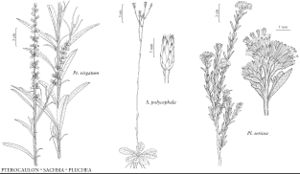Sachsia
Cat. Pl. Cub., 150. 1866.
| Taxon | Illustrator ⠉ | |
|---|---|---|
 | Pterocaulon virgatum Sachsia polycephala Pluchea sericea | Barbara Alongi Barbara Alongi Barbara Alongi |
Perennials, 10–60+ cm; fibrous-rooted, sometimes rhizomatous. Stems erect (scapiform), simple or distally branched, finely glandular, bases sericeous-woolly. Leaves all or mostly basal, alternate; sessile; blades obovate to oblanceolate or spatulate, bases not clasping, margins denticulate to dentate [pinnatifid], abaxial faces ± sericeous and glandular, adaxial glabrous (shiny, venation raised, reticulate). Heads radiate or disciform, in loose, corymbiform to paniculiform arrays. Involucres cylindric-ovoid to urceolate, 2–3 mm diam. Phyllaries falling in fruit, in 5–6 series, lanceovate to lance-linear, unequal. Receptacles flat, epaleate. Ray or peripheral (pistillate) florets in 1 (–3) series, fertile; corollas whitish (tubes filiform, laminae absent or ± developed and apically 3-toothed). Inner (functionally staminate or bisexual) florets 6–18; corollas whitish, lobes (4–) 5. Cypselae cylindric to narrowly ellipsoid, ribs 8–12 (white, raised), faces strigillose; pappi persistent (fragile), of distinct or basally connate, smooth or barbellulate bristles in 1 series. x = 10.
Distribution
Fla., West Indies (Bahamas), West Indies (Cuba), West Indies (Hispaniola), West Indies (Jamaica)
Discussion
Species 3 (1 in the flora).
The monotypic Rhodogeron Grisebach was transferred to Sachsia by A. A. Anderberg, who noted (1991b) that “…it is a derived relative of Sachsia. The two differ only in the shape of the leaves and the female florets” (leaves pinnatifid, ray florets with laminae well developed and relatively broad in Rhodogeron). Anderberg placed Sachsia as “Plucheeae insertae sedis,” and noted that “…the genus is anomalous, but could prove to belong in the Plucheeae, in spite of its acute sweeping hairs.” The two species of Sachsia other than S. polycephala are endemic to Cuba.
Selected References
None.